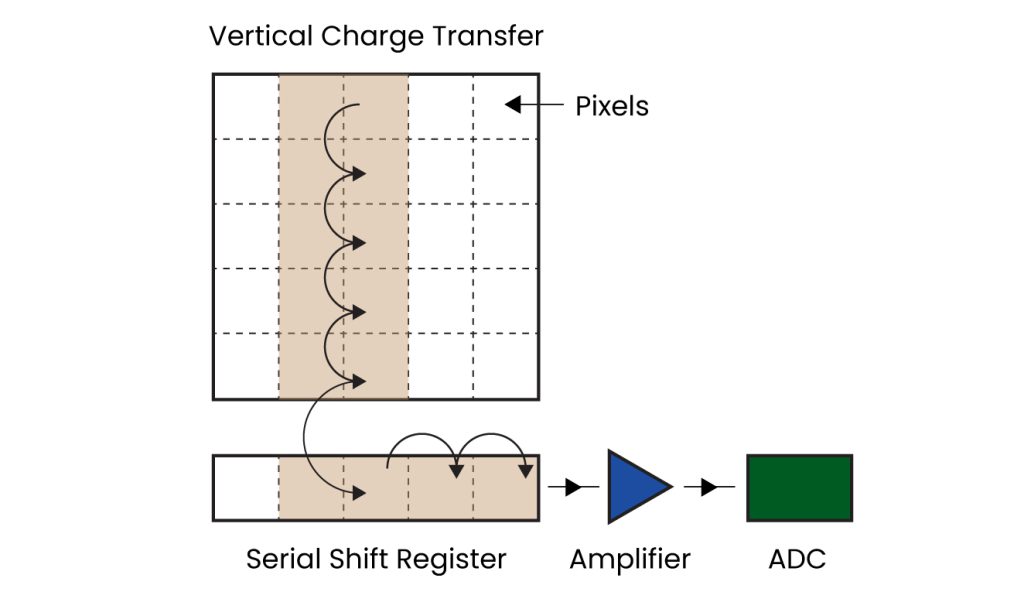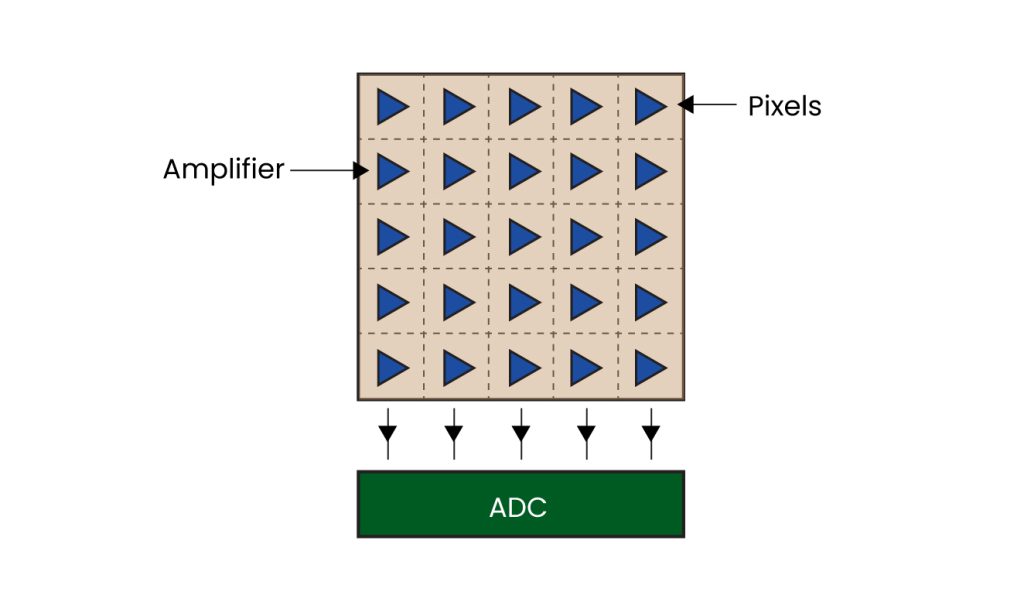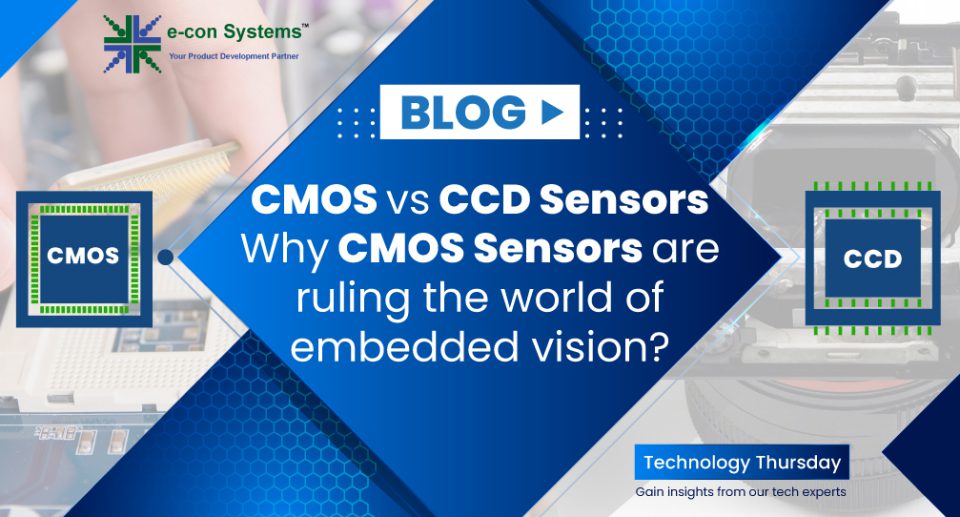The invention of image sensors dates back to the 1960s. This journey started with designing the MOS (Metal Oxide Semiconductor) sensor architecture in the early 60s and developing the first digital camera in 1969 to the unraveling of the latest SPAD (Single Photon Avalanche Diode) technique from Canon.
However, CCD and CMOS sensors have remained two of the most popular sensor technologies in the imaging space for decades. CMOS sensors, in particular, have started becoming more popular in the embedded vision space. While a vast majority of the discussions around the comparison of these two technologies have revolved around mobile phone cameras and machine vision systems, not much has been spoken about in light of embedded vision.
In this article, let’s examine some of the key differences between CMOS and CCD sensors, why CMOS is gaining on—or is already beating—CCD, and what the future holds.
What are CCD and CMOS sensors?
Both CCD and CMOS technologies use the photoelectric effect to convert packets of light (or photons) into electric signals. Also, these two sensors are made up of pixel wells that collect these incoming photons.
CCD (Charge Coupled Device) sensors
A CCD sensor is an analog device. Below the CCD layer lies the SSR (Serial Shift Register), which is connected to an amplifier on one end and an ADC (Analog to Digital Converter) on the other. The charge in the CCD layer is transferred to the SSR and then to the amplifier and the ADC. This charge is read from each pixel site to recreate the image. Have a look at the below diagram to understand how the whole process works:

In a CCD sensor, when photons are converted into electric signals, the charge to be converted into voltage is transferred through a limited number of nodes. This means that only a few amplifiers and ADCs are in action, which in turn results in less noise in the output image.
CMOS (Complementary Metal Oxide Semiconductor) sensors
A CMOS sensor, or Complementary Metal-Oxide-Semiconductor sensor, is a type of image sensor used in cameras and imaging devices. It converts light into electronic signals to create digital images. CMOS sensors are known for their low power consumption and high-speed capabilities.
One difference between a CMOS and a CCD sensor is that the former has an amplifier in every pixel. In some CMOS sensor configurations, each pixel has an ADC as well. It results in higher noise compared to a CCD sensor. But this setup makes it possible to read several sensor pixels simultaneously. To understand the architecture of a CMOS sensor, please have a look at the below image:

CMOS sensors vs. CCD sensors: Key differences
A one-on-one comparison of CCD and CMOS sensors can be done along five different parameters:
- Sensitivity: Until recently, CCD had an imaging edge over CMOS in low light conditions as well as in the NIR (Near Infra-Red) region. Advancements in the CMOS sensor technology, though, are helping it close in on CCD sensors.
- Noise and image quality: Having a lower number of ADCs and amplifiers helps CCD sensors deliver images with less noise in comparison with CMOS sensors. But sensor manufacturers are consistently coming up with innovative techniques to enhance the image quality of CMOS sensors.
- Power consumption: Compared to CCD sensors, CMOS sensors draw less power which is useful in embedded vision systems that have other power-hungry components in them.
- Supply chain and availability: With more sensor manufacturers moving away from the CCD technology, the availability of these sensors has been drastically reduced in the last few years. Also, if you are looking for a CCD supplier, you are likely to end up with fewer options as opposed to a large universe of vendors for CMOS sensors.
- Cost: CMOS easily wins the race when it comes to cost.
CCD sensors and CMOS sensors for low-light and NIR imaging
CCD sensors remained the natural choice for many product developers for a very long time when it came to building camera-based devices that needed to operate under low lighting conditions or an IR/NIR light source.
This was true, especially in higher temperature ranges where CMOS sensors needed an additional cooler to maintain the required level of QE (Quantum Efficiency – a measure that indicates the sensitivity of a sensor).
This was also owing to the fact that CCD sensors offered the flexibility of having a thicker substrate layer for the absorption of photons in the NIR spectrum. However, recent developments in CMOS sensor technology have given birth to sensors that offer better sensitivity than traditional CCD sensors.
For instance, the Sony STARVIS series includes a wide variety of sensors with superior low-light performance and NIR sensitivity.
Why CMOS sensors are winning the embedded vision race
As discussed earlier, CMOS cameras are catching up on CCD cameras when it comes to most imaging parameters. Reduced costs with matching performance are encouraging more and more product developers to pick CMOS sensors over CCD sensors. For the same reason, sensor manufacturers are also gradually moving away from developing new CCD sensors.
Hence, not much research or advancement is happening in the space. It results in a cascade effect that reduces the popularity of CCD sensors over time.
Moreover, many imaging applications like medical microscopy that stayed with CCD for much longer compared to other embedded vision applications have also joined the ‘CMOS wave’. Further, in addition to power consumption advantages, CMOS sensors also tend to offer higher frame rates and better dynamic range. This has also led embedded camera companies to come up with cutting-edge camera solutions using CMOS sensors.
Given these factors, it’s no wonder that CMOS cameras have established their supremacy in embedded vision.
Popular applications of CMOS sensor-based cameras
Autonomous Mobile Robots (AMRs)
CMOS cameras are preferred in AMRs due to their high-speed image processing and low power consumption. These enable real-time navigation and obstacle detection. They also provide excellent image quality, enabling the robots to interpret their environment accurately and make quick decisions.
Fleet management systems
Fleet management systems use CMOS cameras for their reliability and ability to operate across different lighting conditions. These cameras offer high-resolution imaging and fast data transfer, which are required for monitoring vehicle movements, detecting incidents, and ensuring the safety of the fleet and its drivers.
Medical diagnostic devices
Medical diagnostic devices need CMOS cameras to obtain superior–quality images with high sensitivity, which is crucial for accurate diagnosis. Such cameras help in the early detection and treatment of medical conditions. Furthermore, their compact size and low power requirements make them suitable for handheld diagnostic tools.
In-vehicle surround-view systems
In-vehicle surround view systems prefer CMOS cameras for their ability to deliver high-resolution, distortion-free images. They improve driver awareness by offering a complete view of the vehicle’s surroundings, which helps functions like parking and maneuvering in tight spaces. Moreover, the wide dynamic range and excellent low-light performance of CMOS cameras ensure clear visibility in all conditions.
Patrolling robots
Patrolling robots leverage CMOS cameras for their high-speed image capture and processing capabilities, making them perfect for real-time surveillance and threat detection. They offer reliable performance in varying lighting conditions, enabling the robots to monitor large areas and respond to security breaches promptly.
CCD sensors and CMOS sensors – what the future holds
With further developments stalled, we are likely to soon witness the death of CCD sensors. In fact, many sensor manufacturers stopped producing them years ago but are merely continuing to support their existing customers.
While the outlook for CCD sensors may be bleak, the future of CMOS sensors is shiny. From the introduction of global shutters to the development of extremely low-light and high-resolution cameras, the pace of advancements in CMOS technology is nothing short of rapid.
With leading sensor manufacturers such as Sony, Onsemi, Omnivision etc. putting more focus on enhancing the sensitivity, resolution, dynamic range, power efficiency, and more of CMOS sensors, innovations in the space are happening with lightning speed.
CMOS Cameras offered by e-con Systems
e-con Systems™ has 20+ years of experience in designing, developing, and manufacturing OEM cameras. Our wide portfolio of CMOS cameras includes the below:
- 16MP autofocus USB Camera
- 4K HDR Camera
- Global Shutter Camera Module
- IP67-Rated Full HD GMSL2 HDR Camera Module
- IP66-Rated AI Smart Camera
To get a complete view of our portfolio, please visit our Camera Selector Page.
If you need any help integrating the right camera solution into your application, please write to camerasolutions@e-consystems.com.

Prabu is the Chief Technology Officer and Head of Camera Products at e-con Systems, and comes with a rich experience of more than 15 years in the embedded vision space. He brings to the table a deep knowledge in USB cameras, embedded vision cameras, vision algorithms and FPGAs. He has built 50+ camera solutions spanning various domains such as medical, industrial, agriculture, retail, biometrics, and more. He also comes with expertise in device driver development and BSP development. Currently, Prabu’s focus is to build smart camera solutions that power new age AI based applications.




